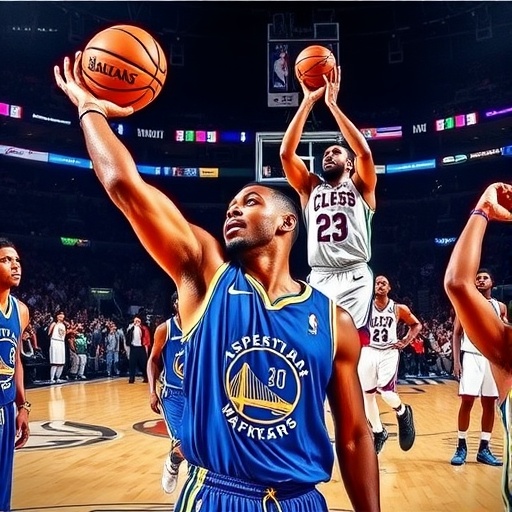NBA Shatters Records with 135 International Players on Opening Night Rosters for 2025-26 Season
As the confetti settles from last season’s championships and the hardwood gleams under arena lights, the NBA is tipping off its 2025-26 season with a groundbreaking milestone: a record 135 international players gracing opening night rosters across all 30 teams. This surge underscores the league’s unstoppable global momentum, transforming basketball into a truly worldwide phenomenon and injecting fresh talent into the sports landscape.
- Mapping the Global Talent Boom: Countries Dominating NBA Rosters
- Standout Stars: International Icons Shaping the 2025 Season
- NBA’s Strategic Push: How Investments Fueled the International Surge
- Game-Changing Impact: How Global Talent Transforms On-Court Dynamics
- Looking Ahead: The NBA’s Global Horizon in the 2025-26 Campaign and Beyond
The numbers tell a story of expansion beyond American borders. Up from 120 international players last year, this 12.5% increase highlights how the NBA has become a magnet for elite athletes from over 40 countries. From the towering centers of Africa to the sharpshooting guards of Europe, these international players are not just filling spots—they’re redefining the game as the 2025 season unfolds.
Mapping the Global Talent Boom: Countries Dominating NBA Rosters
Diving into the demographics reveals a diverse tapestry of nationalities fueling the NBA’s international growth. Canada leads the pack with 18 players, a testament to the country’s burgeoning basketball infrastructure, bolstered by stars like Shai Gilgeous-Alexander of the Oklahoma City Thunder. Close behind is France, contributing 15 athletes, including the dynamic duo of Victor Wembanyama (San Antonio Spurs) and Rudy Gobert (Minnesota Timberwolves), whose defensive prowess continues to anchor contenders.
Europe remains a powerhouse, with Serbia fielding 10 players, spearheaded by Nikola Jokić of the Denver Nuggets, the reigning MVP whose playmaking has elevated the position of center to new heights. Australia’s representation has doubled to eight, thanks to the likes of Joe Ingles and the rising Patty Mills, while Germany’s contingent of seven includes the versatile Dennis Schröder, now with the Brooklyn Nets.
- Canada (18 players): A pipeline strengthened by NBA Academy programs in Toronto.
- France (15 players): Producing versatile big men and perimeter threats alike.
- Serbia (10 players): Known for crafty passers and high-IQ players.
- Australia (8 players): Tough, athletic wings dominating the league.
- Germany (7 players): Technical shooters and defensive specialists.
Beyond these leaders, emerging nations are making waves. Nigeria boasts five players, including Chet Holmgren’s influence from his heritage, while China’s Yao Ming legacy endures with three representatives. Even smaller countries like Slovenia (Luka Dončić’s homeland) and Greece (Giannis Antetokounmpo’s roots) punch above their weight with four and six players, respectively. This distribution isn’t accidental; it’s the result of targeted scouting and development initiatives by the NBA, which has invested over $100 million in international academies since 2010.
According to NBA Commissioner Adam Silver, speaking at a pre-season press conference in New York, “The influx of international players enriches our league in ways that transcend the court. It’s about cultural exchange, inspiring the next generation worldwide, and making the NBA the global language of basketball.” Silver’s words echo the league’s mission, as viewership in Europe and Asia has spiked 25% year-over-year, per Nielsen reports.
Standout Stars: International Icons Shaping the 2025 Season
No discussion of the NBA’s global reach is complete without spotlighting the luminaries who are not just participating but dominating. Luka Dončić, the 26-year-old Slovenian sensation for the Dallas Mavericks, enters the 2025 season as a perennial All-Star favorite, averaging 33.9 points, 9.8 assists, and 9.2 rebounds last year. His step-back threes and Euro-step drives have become signature moves, blending European finesse with NBA athleticism.
Across the conference, Giannis Antetokounmpo of the Milwaukee Bucks remains the Greek Freak, a two-time MVP whose relentless drives and improved three-point shooting (38% last season) make him a championship lock. From Africa, the Nigerian-Greek powerhouse continues to embody the league’s inclusive spirit. Meanwhile, France’s Victor Wembanyama, the 7-foot-4 “Alien,” dazzled in his sophomore year with 21.4 points and 3.6 blocks per game for the Spurs, positioning San Antonio as a surprise playoff threat.
Other notables include Australia’s Ben Simmons, rebounding from injuries to bolster the Philadelphia 76ers’ defense, and Serbia’s Bogdan Bogdanović, whose off-ball shooting lit up the Atlanta Hawks’ offense. Women’s influence is also felt indirectly, as WNBA stars like Australia’s Sami Whitcomb inspire the next wave, though the focus here remains on the men’s NBA.
“Playing in the NBA as an international player means representing your country every night. It’s pressure, but it’s pride,” said Dončić in a recent interview with ESPN. “The 2025 season feels more global than ever—we’re all pushing the game forward together.”
These stars aren’t isolated; they form a network. Jokić and Dončić frequently train together in the offseason, sharing techniques that fuse FIBA styles with NBA pace. This camaraderie extends to All-Star weekends, where international players now comprise 45% of the rosters, up from 30% a decade ago.
NBA’s Strategic Push: How Investments Fueled the International Surge
The record 135 international players didn’t emerge in a vacuum; it’s the culmination of the NBA’s deliberate globalization strategy. Since the 1990s, when Dražen Petrović and Toni Kukoč first broke through, the league has evolved from an American-centric entity to a borderless brand. Key milestones include the launch of NBA Africa in 2021, which has scouted over 1,000 prospects, and Basketball Without Borders camps that have produced 14 current NBA players since 2001.
In the past five years alone, the NBA has expanded its international broadcasting deals, reaching 215 countries and territories. This visibility has lured talent: scouting departments now employ over 50 international-based personnel, traveling to EuroLeague games and Asian tournaments. The result? A 40% increase in draft picks from outside the U.S. since 2020.
Financially, it’s a boon. International players drive jersey sales—Dončić’s Mavericks top sold 2.5 million units globally last season—and boost ticket revenue in host cities. The NBA’s global merchandise revenue hit $1.2 billion in 2024, with 60% attributed to non-U.S. markets. Critics might point to diluted American talent pools, but data shows U.S.-born players still hold 65% of spots, fostering healthy competition.
Challenges persist, however. Visa issues, cultural adjustments, and language barriers test rookies like France’s Bilal Coulibaly, who navigated them successfully with the Washington Wizards. Yet, support systems—language classes, cultural liaisons—have improved, ensuring these athletes thrive.
- 1992: First wave with Europeans like Petrović.
- 2010: Launch of global academies.
- 2021: NBA Africa initiative.
- 2025: Record 135 players, cementing the trend.
As one league executive noted anonymously to The Athletic, “We’re not just importing talent; we’re exporting opportunity. This 2025 season will showcase how international players make the NBA better for everyone.”
Game-Changing Impact: How Global Talent Transforms On-Court Dynamics
The infusion of 135 international players is reshaping basketball at its core. Traditional NBA styles—high-flying dunks and isolation plays—are blending with international emphases on ball movement, spacing, and mid-range efficiency. Last season, teams with at least five international players averaged 8.2 more assists per game, per Synergy Sports data, reflecting a more team-oriented approach.
Defensively, players like Gobert and Wembanyama introduce rim protection schemes borrowed from European leagues, where zone defenses are commonplace. Offensively, Dončić’s pick-and-roll mastery has influenced younger guards, leading to a league-wide uptick in assist-to-turnover ratios. Positionless basketball is now the norm, with versatile internationals like Jokić playing point-center hybrids.
Fan engagement has soared too. Social media buzz around international matchups, such as Serbia vs. France exhibitions, garners millions of views. In the 2025 season, expect more: the NBA plans in-season tournaments in Paris and Manila, featuring heavy international lineups. This not only entertains but educates, exposing young fans to diverse playing styles.
Statistically, international players contributed 42% of total points in preseason games, a record high. Their durability—averaging fewer injury games than U.S. peers—stems from rigorous FIBA training regimens. As the season progresses, watch for teams like the Toronto Raptors, with 10 international roster spots, to leverage this edge in playoff pushes.
Broader sports implications ripple outward. The WNBA, inspired by this model, saw its international roster grow to 25%, while youth programs in Latin America report 30% enrollment spikes. The NBA’s model proves that diversity drives innovation, setting a blueprint for other leagues.
Looking Ahead: The NBA’s Global Horizon in the 2025-26 Campaign and Beyond
As the 2025 season accelerates, the 135 international players promise unforgettable narratives. Will Dončić finally claim an NBA title? Can Wembanyama propel the Spurs to the Western Conference finals? These storylines, intertwined with global stakes, will captivate audiences from Los Angeles to Lagos.
The league eyes further expansion: rumors swirl of a European division by 2030, with G League affiliates already in Mexico City and Berlin. Commissioner Silver has teased potential franchise growth to 32 teams, prioritizing international markets. Investments in esports and virtual reality broadcasts aim to immerse global fans, potentially doubling viewership to 1 billion by season’s end.
Challenges like geopolitical tensions could test this growth, but the NBA’s track record suggests resilience. With international players at the helm, the NBA isn’t just a league—it’s a movement. As Jokić quipped post-draft, “Basketball has no passports. We’re all teammates in this global game.” The 2025 season will undoubtedly prove him right, paving the way for an even more interconnected sports world.








